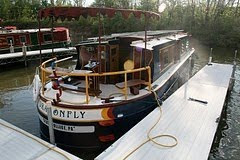 |
| I am not a pig. I am a "Hoover Hog" |
Maybe you've heard this joke. Guy drives by a farm and sees a three-legged pig, wearing a wooden leg. Guy asks the farmer, "What's up with that pig?" Farmer says, "Last year, the house caught fire. We passed out in the smoke. Pig used his mouth to turn the doorknob. Dialed 9-1-1 with his snout. Then ran upstairs and dragged us out of our beds and out of the house."
"That's remarkable," says the man. "And the pig got injured in the fire?" "Nope," says the farmer. "A pig that smart, you don't eat him all at once."
I thought of this joke Friday, when we bought some locally caught stone crab claws at the Steinhatchee Fish Market.
The guy who sold us our dinner, a jolly Santa look-alike, was also the guy who had caught it--about a mile away. Not much fossil fuel burned to transport THIS meal to our table.
Santa approved of our choice. "You know that's a real sustainable fishery, right?"
We didn't know.
Usually, when you talk about sustainable fishing practices, that means, limiting the number (or pounds) of fish caught, or closing certain areas to fishing, or both. In the case of stone crabs, sustainable fishing means, "No crabs were killed to bring you this delicious dinner."
See, what fishermen do is haul in their crab traps, take the crabs out, and snap off the larger of the two claws. Then throw the crab back in the water, still live and snapping.
In a year to couple of years (stone crabs live to be 5 to 7 years old), that crab grows back a whole 'nother claw. Really. In fact, on any given serving plate piled high with steaming crab claws, about one out of every seven tasty tidbits is a second-growth, regenerated claw.
Gulp. Sounds gruesome.
"Doesn't hurt the crab," Santa said. "The claw breaks off easy. And it has a little membrane at the joint that seals it off, naturally. It's how crabs escape their predators."
Kind of like lizards with tails that break off easily, or butterflies that shed scales from their wings as they escape from birds.
Biologists from the Florida Fish and Wildlife Commission confirm that, if crab fishermen use the proper technique, the leg breaks off cleanly, and the crab is not killed.
I've been looking around, but so far I can't find any research that tells how good a job crab fishermen do. How many crabs are killed--as opposed to unharmed--when their claw is snapped off? A tiny number? A large number? Is it no big deal either way, since any dead crabs are readily recycled by other ocean creatures?
And with an admittedly quick search I couldn't find any hard data on whether one-legged crabs are at any reproductive disadvantage. Are they less able to get mates? repel predators? Their main enemies are octopus,which are not deterred by the claws.
Is it harder for them to feed? Only if they lose BOTH claws, say the biologists. Are so many crab claws harvested that these disadvantages could make a difference? Or are crabs so numerous, or so prolific, it's not a problem?
The National Marina Fisheries Service says the species is not overfished--unlike a couple of other local specialities you see on every local restaurant menu, red snapper and grouper. (More on them later). And regulations do prohibit taking claws from female crabs when they are carrying eggs. Regulations have also reduced so-called "by-catch"; since 1979, crab fisherman have been required to use traps with an "escape panel" that lets other creatures get away.
Also, you can't take a claw unless it is at least 2 3/4 inches long. That means only crabs that likely have reproduced are part of the harvest.
So there you have it. On the one hand, there's the "yuck" factor, like the three-legged pig. Are you OK with dipping a pile of amputated limbs in melted butter?
On the other hand, eating stone crab claws COULD be compared to eating apples--you're eating a part that can easily be removed without harming the whole, adult organism--a part that grows back next season.
Or like maybe it's more like eating eggs, or milk, or . . . I'm really striving for a good analogy . . . Rocky Mountain oysters? You get to consume some high quality animal protein . . . without actually killing an animal.
Whichever you think, it's literally food for thought.





Ha! Kind of gross, but funny. I'm intrigued by the photo you posted. Is that a local animal? How can something look so much like an armadillo and not be one? Naomi
ReplyDeleteActually it IS an armadillo. (And you should have seen the funny looks I got from native Floridians as I crouched by the side of the road with my telephoto, shooting this picture! Many folks consider them pests) In the photo caption, click the blue words "Hoover hog" for an explanation!
ReplyDeleteOH!!! HOOVER!!! As in Herbert Hoover! DUH!!! I was thought you said "hover pig" as in flying armadillos! Boy do I feel stupid! I gotta start paying closer attention when I read...
ReplyDelete